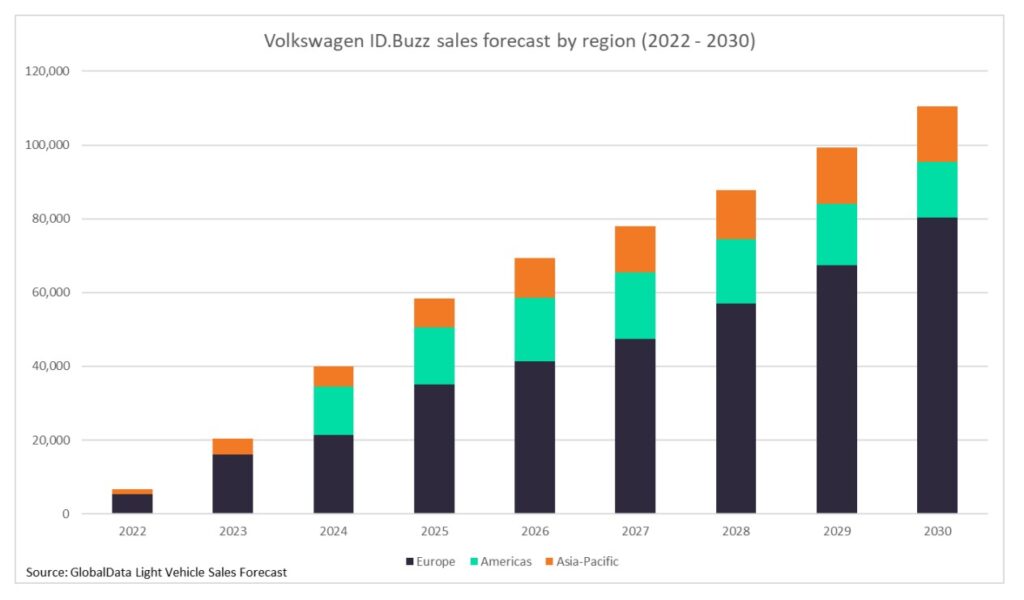
Among Volkswagen’s battery-electric ID lineup, perhaps no model has caused quite as much excitement as the ID.Buzz. This part-van-part-MPV is both visually and thematically positioned as the spiritual successor to the popular Type 2 Transporter, which became an icon of mid-20th-century motoring thanks to its flexible interior and ‘cute’, rounded styling.
After years of teasers and previews, VW has finally begun full production of the ID.Buzz at its Hanover commercial vehicle factory, with the first models destined to hit the European market later in 2022. The company expects early production to be modest, with estimates for 2022 hovering maxing out at around 15,000 models, but could be fewer if there are any speedbumps in the production ramp up. Ultimately, VW believes the Hanover line could produce as many as 130,000 ID.Buzz models per year, split between passenger and cargo versions.
Looking to our latest sales forecasts for the new model, we foresee VW reaching this level of sales around 2030. Typically, for a new model, we expect sales to rapidly ramp up towards the start of its lifecycle as consumer hype will be the greatest at this point. From there, we generally see a gradual decline as the model gets older and potential customers start migrating to rival brands with newer alternatives. We expect the ID.Buzz to buck this trend, however, as sales numbers are likely to be limited by production – in other words, VW will sell every single ID.Buzz it makes, with parts supply being the key limiting factor so, as those supplies recover, more can be built and, thus, more will be sold.
With the hype surrounding the ID.Buzz, one might feel confident in hailing the vehicle as a definite future sales success for VW. However, we believe the model has a handful of shortcomings that might limit its appeal when it goes on sale. One potential issue is price. Entry-level cargo versions are expected to launch costing around EUR46,000, while passenger variants will cost around EUR10,000 more. This is quite high and could put the ID.Buzz out of reach for the buyers it hopes to target, potentially dampening volumes unless prices drop in future. Indeed, that price pits it against models including the Tesla Model Y and, in the US, the Ford F-150 Lightning – both of which are likely to have a larger addressable customer base.
Another potential issue the new ID.Buzz will face is VW’s decision to initially launch the passenger variant in Europe in five-seat form only. Most MPV and van rivals that the ID.Buzz will be cross-shopped against have at least seven seats and buyers in this segment expect a certain level of practicality from their vehicle. That the ID.Buzz will be costly in addition to offering fewer seats than most alternatives could limit its appeal and, thus, sales. VW plans to offer the ID.Buzz in several different configurations in the future – including a seven-seat, long-wheelbase option – but the decision not to launch with a range-topping seven-seat version risks either underwhelming buyers or encouraging them to wait for enhanced, future variants.

See also: VW component parts supplying to ID.Buzz

US Tariffs are shifting - will you react or anticipate?
Don’t let policy changes catch you off guard. Stay proactive with real-time data and expert analysis.
By GlobalDataThis article was first published on GlobalData’s dedicated research platform, the Automotive Intelligence Center



